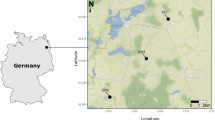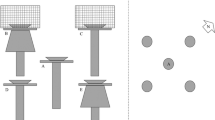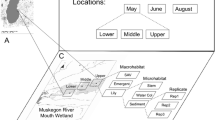Abstract
Dispersal connects patches within metapopulations and is crucial to the persistence of many species, particularly those living in discontinuous habitat. Rock pools are excellent habitats in which to study dispersal in time as well as space, because many of the organisms that live within them make resistant long-lived dormant stages, they are often abundant, and they are easy to sample. The rock pools on Appledore Island, Gulf of Maine, USA, are home to several cladocerans, including Moina macrocopa and Daphnia pulex × pulicaria hybrids. Both taxa exist in extremely high abundances in some pools and make diapausing eggs enclosed in ephippia that are dispersed in time by hatching long after they are produced, and are also known to spatially disperse via pool overflows and by adhering to gulls. I hypothesized that ephippia of both taxa would also be spatially dispersed by wind. I found that while Moina are present in more pools, more abundant in those pools, and produce more ephippia, many more Daphnia ephippia dispersed into traps placed around the island. This may be explained, in part, by differences in the buoyancy of ephippia between the two species. A higher propensity to disperse may result in Daphnia relying more heavily on the spatial context of rock pools than Moina.





Similar content being viewed by others
References
Allen MR (2007) Measuring and modeling dispersal of zooplankton. Oecologia 153:135–143
Altermatt F, Ebert D (2008) The influence of pool volume and summer desiccation on the production of the resting and dispersal stage in a Daphnia metapopulation. Oecologia 157:441–452
Altermatt F, Ebert D (2010) Populations in small, ephemeral habitat patches may drive dynamics in a Daphnia magna metapopulation. Ecology 91:2975–2982
Altermatt F, Pajunen VI, Ebert D (2008) Climate change affects colonization dynamics in a metacommunity of three Daphnia species. Global Change Biol 14:1209–1220
Amarasekare P (2008) Spatial dynamics of foodwebs. Annu Rev Ecol Evol Syst 39:479–500
Angert AL, Huxman TE, Chesson P, Venable DL (2009) Functional tradeoffs determine species coexistence via a storage effect. Proc Natl Acad Sci 106:11641–11654
Bates D, Maechler M, Bolker B, Walker S (2015) Fitting linear mixed-effects models using lme4. J Stat Softw 67:1–48
Bilton DT, Freeland JR, Okamura B (2001) Dispersal in freshwater invertebrates. Annu Rev Ecol Syst 32:159–181
Bohonak AJ, Jenkins DG (2003) Ecological and evolutionary significance of dispersal by freshwater invertebrates. Ecol Lett 6:783–796
Boileau MG, Hebert PDN, Schwartz SS (1992) Non-equilibrium gene frequency divergence: persistent founder effects in natural-populations. J Evol Biol 5:25–39
Brendonck L, Riddoch BJ (1999) Wind-borne short-range egg dispersal in anostracans (Crustacea: Branchiopoda). Biol J Linn Soc 67:87–95
Brendonck L, Joque M, Hulsmans A, Vanschoenwinkel B (2010) Pools ‘on the rocks’: freshwater rock pools as model system in ecological and evolutionary research. Limnetica 29:25–40
Burnham KP, Anderson DR (2002) Model selection and multimodel inference: a practical information-theoretic approach. Springer, New York
Cáceres CE, Soluk DA (2002) Blowing in the wind: a field test of overland dispersal and colonization by aquatic invertebrates. Oecologia 131:402–408
Cáceres CE, Christoff AN, Boeing WJ (2007) Variation in ephippial buoyancy in Daphnia pulicaria. Freshw Biol 52:313–318
Cohen GM, Shurin JB (2003) Scale-dependence and mechanisms of dispersal in freshwater zooplankton. Oikos 103:603–617
Cristescu ME, Constantin A, Bock DG, Cáceres CE, Crease TJ (2012) Speciation with gene flow and the genetics of habitat transitions. Mol Ecol 21:1411–1422
D’Abramo LR (1980) Ingestion rate decrease as the stimulus for sexuality in populations of Moina macrocopa. Limnol Oceanogr 25:429–433
De Meester L, Gomez A, Okamura B, Schwenk K (2002) The Monopolization hypothesis and the dispersal-gene flow paradox in aquatic organisms. Acta Oecol 23:121–135
De Stasio BT Jr. (1989) The seed bank of a freshwater crustacean: copepodology for the plant ecologist. Ecology 70:1377–1389
De Stasio BT Jr. (1990) The role of dormancy and emergence patterns in the dynamics of a freshwater zooplankton community. Limnol Oceanogr 35:1079–1090
Ellis JC, Good TP (2006) Nest attributes, aggression, and breeding success of gulls in single and mixed species subcolonies. The Condor 108:211–219
Elzinga JA, van Nouhuys S, van Leeuwen DJ, Biere A (2007) Distribution and colonization ability of three parasitoids and their herbivorous host in a fragmented landscape. Basic Appl Ecol 8:75–88
Fowler-Billings K (1959) Geology of the Isles of Shoals. New Hampshire State Planning and Development Commision, Concord
Frisch D, Green AJ, Figuerola J (2007) High dispersal capacity of a broad spectrum of aquatic invertebrates via waterbirds. Aquat Sci 69:568–574
Gerrish GA, Cáceres CE (2003) Genetic versus environmental influence of pigment variation in the ephippia of Daphnia pulicaria. Freshw Biol 48:1971–1982
Gyllström M, Hansson LA (2004) Dormancy in freshwater zooplankton: induction, termination, and importance of benthic–pelagic coupling. Aquat Sci 66:274–295
Hairston NG Jr (1998) Time travelers: what’s timely in diapause research? Ergeb Limnol 52:1–15
Hairston NG Jr, Cáceres CE (1996) Distribution of crustacean diapause: micro- and macroevolutionary pattern and process. Symposium on Diapause in the Crustacea. Hydrobiologia 320:27–44
Hairston NG Jr, Kearns CM (2002) Temporal dispersal: ecological and evolutionary aspects of zooplankton egg banks and the role of sediment mixing. Integr Comp Biol 42:481–491
Hairston NG Jr, Olds EJ, Munns WR (1985) Bet-hedging and environmentally cued diapause strategies of diaptomid copepods. Verh Internat Verein Limnol 22:3170–3177
Hairston NG Jr, Ellner S, Kearns CM (1996) Overlapping generations: the storage effect and the maintenance of biotic diversity. In: Rhodes OE Jr, Chesser RK, Smith MH (eds) Population dynamics in ecological space and time. University of Chicago Press, Chicago, pp 109–145
Hanski IE, Ranta E (1983) Coexistence in a patchy environment: three species of Daphnia in rock pools. J Anim Ecol 52:263–279
Havel JE, Shurin JB (2004) Mechanisms, effects, and scales of dispersal in freshwater zooplankton. Limnol Oceanogr 49:1229–1238
Havel JE, Colbourne JK, Hebert PDN (2000) Reconstructing the history of intercontinental dispersal in Daphnia lumholtzi by use of genetic markers. Limnol Oceanogr 45:1414–1419
Hebert PDN, Finston TL (2001) Macrogeographic patterns of breeding system diversity in the Daphnia pulex group from the United States and Mexico. Heredity 87:153–161
Hebert PDN, Beaton MJ, Schwartz SS, Stanton DJ (1989) Polyphyletic origins of asexuality in Daphnia pulex. I. Breeding system variation and levels of clonal diversity. Evolution 43:1004–1015
Hulsmans A, Moreau K, De Meester L, Riddoch BJ, Brendonck L (2007) Direct and indirect measures of dispersal in the fairy shrimp Branchipodopsis wolfi indicate a small scale isolation-by-distance pattern. Limnol Oceanogr 52:676–684
Jenkins DG, Buikema AL Jr (1998) Do similar communities develop in similar sites? A test with zooplankton structure and function. Ecol Monogr 68:421–443
Joque M, Vanschoenwinkel B, Brendonck L (2010) Freshwater rock pools: a review of habitat characteristics, faunal diversity and conservation value. Freshw Biol 55:1587–1602
Juračka PJ, Declerck SAJ, Vondrák D, Beran L, Černý M, Petrusek A (2015) A naturally heterogeneous landscape can effectively slow down the dispersal of aquatic microcrustaceans. Oecologia 180:785–796
Kahle D, Wickham H (2013) ggmap: Spatial visualization with ggplot2. R J 5:144–161
Leibold MA, Holyoak M, Mouquet N, Amarasekare P, Chase JM, Hoopes MF, Holt RD, Shurin JB, Law R, Tilman D, Loreau M, Gonzalez A (2004) The metacommunity concept: a framework for multi-scale community ecology. Ecol Lett 7:601–613
Levin SA, Cohen D, Hastings A (1984) Dispersal strategies in patchy environments. Theor Popul Biol 26:165–191
Levins R, Culver D (1971) Regional coexistence of species and competition between rare species. Proc Natl Acad Sci USA 68:1246–1248
Loder TC III, Ganning B, Love JA (1996) Ammonia nitrogen dynamics in coastal rockpools affected by gull guano. J Exp Mar Biol Ecol 196:113–129
Louette G, De Meester L (2004) Rapid colonization of a newly created habitat by cladocerans and the initial build-up of a Daphnia-dominated community. Hydrobiologia 513:245–249
Louette G, De Meester L (2005) High dispersal capacity of cladoceran zooplankton in newly founded communities. Ecology 86:353–359
Mergeay J, Verschuren D, De Meester L (2006) Invasion of an asexual American water flea clone throughout Africa and rapid displacement of a native sibling species. Proc R Soc Lond B Biol Sci 273:2839–2844
Miner BE, De Meester L, Pfrender ME, Lampert W, Hairston NG (2012) Linking genes to communities and ecosystems: Daphnia as an ecogenomic model. Proc R Soc Lond B Biol Sci 279:1873–1882
Pajunen VI, Pajunen I (2003) Long-term dynamics in rock pools Daphnia metapopulations. Ecography 26:731–738
Paloheimo J (1974) Calculation of instantaneous birth rate. Limnol Oceanogr 19:692–694
Pellowe-Wagstaffe KE, Simonis JL (2014) The ecology and mechanisms of overflow-mediated dispersal in a rock-pool metacommunity. Freshw Biol 59:1161–1172
Pfrender ME, Spitze K, Lehman N (2000) Multi-locus genetic evidence for rapid ecologically based speciation in Daphnia. Mol Ecol 9:1717–1735
Pinceel T, Vanschoenwinkel B, Brendonck L (2013) Flexible dispersal dimorphism in zooplankton resting eggs: an example of repeated phenotypic coin flipping? Biol J Linn Soc 110:749–756
Pinceel T, Brendonck L, Vanschoenwinkel B (2015) Propagule size and shape may promote local wind dispersal in freshwater zooplankton—a wind tunnel experiment. Limnol Oceanogr. doi:10.1002/lno.10201
R Development Core Team (2012) R: a language and environment for statistical computing. R Foundation for Statistical Computing, Vienna, Austria, B http://www.R-project.org
Scoville AG, Pfrender ME (2010) Phenotypic plasticity facilitates rapid adaptation to introduced predators. Proc Natl Acad Sci 107:4260–4263
Simonis JL (2013) Prey (Moina macrocopa) population density drives emigration rate of its predator (Trichocorixa verticalus) in a rock pool metacommunity. Hydrobiologia 715:19–27
Simonis JL, Ellis JC (2014) Boisterous bathing birds bias β-diversity: frequent dispersal by gulls homogenizes fauna in a rock pool metacommunity. Ecology 95:1545–1555
Ślusarczyk M, Pietrzak B (2008) To sink or float: the fate of dormant offspring is determined by maternal behaviour in Daphnia. Freshw Biol 53:569–576
Ślusarczyk M, Grabowski T, Pietrzak B (2015) Quantification of floating ephippia in lakes: a step to a better understanding of high dispersal propensity of freshwater plankters. Hydrobiologia. doi:10.1007/s10750-015-2437-4
Southwood TRE, Henderson PA (2000) Ecological Methods. Blackwell Sci, Oxford
Vanschoenwinkel B, Gielen S, Vandewaerde H, Seaman M, Brendonck L (2008a) Relative importance of different dispersal vectors for small aquatic invertebrates in a rock pool metacommunity. Ecography 31:567–577
Vanschoenwinkel B, Gielen S, Seaman M, Brendonck L (2008b) Any way the wind blows—frequent wind dispersal drives species sorting in ephemeral aquatic communities. Oikos 117:125–134
Vavrek MJ (2011) fossil: Palaeoecological and palaeogeographical analysis tools. Palaeontologia Electronica 14:1T. http://palaeo-electronica.org/2011_1/238/index.html
Venable DL, Lawlor L (1980) Delayed germination and escape in desert annuals: escape in space and time. Oecologia 46:272–282
Ventura M, Petrusek A, Miró A, Hamrová E, Buñay D, De Meester L, Mergeay J (2014) Local and regional founder effects in lake zooplankton persist after thousands of years despite high dispersal potential. Mol Ecol 23:1014–1027
Zuur A, Ieno E, Walker N, Saveliev AA, Smith GM (2009) Mixed effects models and extensions in ecology with R (statistics for biology and health). Springer, New York
Acknowledgements
I am grateful for help from the staff of Shoals Marine Lab, to J.L. Simonis and J. Morin for their previous work in this system, J.L. Simonis for sharing their pool size data, and S.P. Ellner for working through the calculation for ephippia production. C. Chen and J.A. Tyrell provided field assistance. N.G. Hairston, J.L. Simonis, J.A. Tyrell, R.L. Abbott, A. Petrusek, S. van Nouhuys, and 4 anonymous reviewers provided helpful feedback on earlier versions of this manuscript. This research was supported financially by research grants from Cornell University’s A.W. Mellon Foundation fund, Sigma Xi, the Cornell University Department of Ecology and Evolutionary Biology (EEB), and the EEB Betty Miller Francis Fund. The author was supported by a National Science Foundation Graduate Research Fellowship (Grant No. DGE-1650441). Any opinions, findings, and conclusions or recommendations expressed in this material are those of the author and do not necessarily reflect the views of the National Science Foundation. This is contribution number 179 from Shoals Marine Laboratory.
Author information
Authors and Affiliations
Corresponding author
Additional information
Handling Editor: Piet Spaak.
Rights and permissions
About this article
Cite this article
Sirianni, K.M. Differential wind dispersal of cladoceran ephippia in a rock pool metacommunity. Aquat Ecol 51, 203–218 (2017). https://doi.org/10.1007/s10452-016-9611-2
Received:
Accepted:
Published:
Issue Date:
DOI: https://doi.org/10.1007/s10452-016-9611-2




